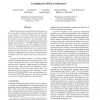Free Online Productivity Tools
i2Speak
i2Symbol
i2OCR
iTex2Img
iWeb2Print
iWeb2Shot
i2Type
iPdf2Split
iPdf2Merge
i2Bopomofo
i2Arabic
i2Style
i2Image
i2PDF
iLatex2Rtf
Sci2ools
CGO
2006
IEEE
2006
IEEE
Compiling for EDGE Architectures
Explicit Data Graph Execution (EDGE) architectures offer the possibility of high instruction-level parallelism with energy efficiency. In EDGE architectures, the compiler breaks a program into a sequence of structured blocks that the hardware executes atomically. The instructions within each block communicate directly, instead of communicating through shared registers. The TRIPS EDGE architecture imposes restrictions on its blocks to simplify the microarchitecture: each TRIPS block has at most 128 instructions, issues at most 32 loads and/or stores, and executes at most 32 register bank reads and 32 writes. To detect block completion, each TRIPS block must produce a constant number of outputs (stores and register writes) and a branch decision. The goal of the TRIPS compiler is to produce TRIPS blocks full of useful instructions while enforcing these constraints. This paper describes a set of compiler algorithms that meet these sometimes conflicting goals, including an algorithm that...
CGO 2006 | Explicit Data Graph Execution | Software Engineering | Trips Blocks | TRIPS EDGE Architecture |
Related Content
| Added | 10 Jun 2010 |
| Updated | 10 Jun 2010 |
| Type | Conference |
| Year | 2006 |
| Where | CGO |
| Authors | Aaron Smith, Jon Gibson, Bertrand A. Maher, Nicholas Nethercote, Bill Yoder, Doug Burger, Kathryn S. McKinley, James H. Burrill |
Comments (0)

